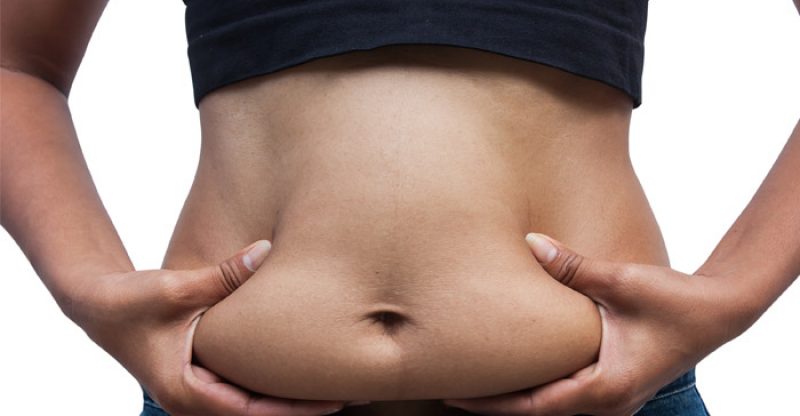How to Lose Visceral Fat – The Ultimate Guide
Why We Gain Lower Visceral Fat
If you’re starting to become more health-conscious, you probably want to know about how to lose visceral fat.
This type of fat is one of the most dangerous health conditions you can deal with, especially when you’ve reached the age of 35, like me.
It’s important to have all the information available on this subject to prevent serious illness, such as diabetes, heart disease, and stroke.
Fortunately, with the proper diet and exercise routine, you can dramatically reduce your risk of developing a debilitating condition.
The following pages will explain what visceral fat is, why we gain it, and how you can easily transform your life to get rid of this silent killer once and for all.
Lower visceral fat accumulates inside the abdominal cavity, surrounding the liver so that it’s mostly invisible to you when you look in the mirror.
I found out that I had high levels of visceral fat when I went to my doctor after having my second child.
She told me that I needed to research this subject and learn more about what visceral fat is.
I began reading about how to reduce my body fat percentage permanently by adopting good habits.
Visceral fat is simply the weight that accumulates normally as you get larger.
It’s the first weight that you’ll gain, and the last bit of fat that you’ll lose, when you go on a diet.
The causes of visceral fat gain are the same as the causes of other types of weight gain.
If you’re genetically predisposed to gain visceral fat, you’ll accumulate it around your midsection when you overeat and live a sedentary lifestyle.
Some other common risk factors for gaining visceral fat include stressful living, excessive drinking, glandular disorders, and taking certain prescription drugs.
As you get older, your metabolic rate slows, and you can begin to gain weight without changing your diet at all.
Women and men are equally likely to gain lower visceral fat, but the probability of acquiring this unwanted weight depends on your DNA.
You can determine whether or not you’re at risk of developing this condition by looking at the members of your family.
If your family members tend to accumulate fat around the midsection, you may be at risk.
If they tend to carry weight below the waistline, you have a much lower risk of developing obesity-related diseases.
If you want to know what visceral fat is, paying attention to your family members can help you answer the question.
My family members all tend to be heavy in the midsection, so I naturally have to worry about gaining visceral weight.
My grandfather died of a heart attack in his 50s, and I’m determined to live as long as possible.
Luckily, losing visceral fat is easy and enjoyable when you understand how to transform your habits to live a more harmonious lifestyle.
Once you’ve made the necessary changes, you’ll realize that maintaining your healthy habits doesn’t require much effort.
You won’t want to go back to your old ways ever again, so staying fit and trim will become like second nature.
Exercises to Reduce Visceral Fat
If you want to know how to get rid of visceral fat, staying active is one of the best strategies at your disposal.
Exercising is also a great way to accelerate your weight loss.
Here is a list of simple exercises you can start doing right away, in most cases without equipment or a gym membership.
Walking
This exercise is first on the list because it’s the easiest to do, and requires no special equipment or preparation.
It’s a good idea to walk as much as possible during your daily routine so that you can burn calories as you get your work done for the day.
If you’re not used to walking, it’s important to ease into the habit to avoid developing shin splits, joint discomfort, and other minor aches and pains.
You may choose to buy a pair of comfortable walking shoes, but almost any footwear will be perfectly suitable for your walk.
The one type of footwear to avoid is flip-flops because they force you to strain your foot muscles in every step, causing cramps and sore legs.
A great way to incorporate more walking into your life is to listen to podcasts, books on tape, or music while you amble through your neighborhood or on nature trails.
Cycling
If you have a bike, I highly recommend riding it to the places you need to go instead of driving a car.
Not only is cycling a high-intensity, low-impact exercise, but it’s an efficient form of transportation that doesn’t burn fossil fuels or cost money for parking.
With a few slight modifications to your bicycle, you can easily use it to do your grocery shopping while getting an effective cardiovascular workout at the same time.
The reason cycling is such a beneficial form of exercise is that it enables you to increase your heart rate without hurting your joints or tendons.
If you want to know how to lose visceral fat, raising your heart rate for an extended period of time is a great way to begin.
Visceral fat tends to be the hardest weight to lose because it’s embedded in your abdominal cavity, even if you have a healthy body mass.
High-intensity cycling helps you cut through the stubborn visceral fat, even when other methods don’t seem to work.
Stair-Stepping
This exercise is high on the list because it’s another easy one to do without any special equipment or preparation.
If you work or go to school in a building with an elevator, simply use the staircase when you need to go to a different floor.
Stair-stepping is an excellent form of exercise because it strengthens your leg muscles while burning a large number of calories.
When you’re trying to figure out how to get rid of visceral fat, targeting your legs can really speed up the process because they’re part of your largest muscle group.
Your body will respond by using stored fat as fuel for your workout.
You’ll be able to watch the visceral fat melt away from your abdomen in a matter of weeks.
The trick is to do this exercise in the morning on an empty stomach to force your body to get energy from fat instead of carbohydrates.
If your legs feel sore after the first day of stair-stepping, take two to three days off to let them recover.
They probably won’t feel sore again when you get back to exercising.
Elliptical Training
This is my favorite form of exercise because it’s the easiest and most versatile one on the list.
However, it does require a gym membership or a purchase of equipment.
Elliptical machines typically come with a wide range of pre-programmed routines and helpful functions such as uphill resistance and training sequences.
They enable you to target your legs and upper body at the same time, burning a large number of calories and fat in a short period.
Elliptical machines help you prevent injury by providing a very low-impact workout, so they’re generally safe to use even with sore muscles or joint aches.
On most machines, you can choose to use the arm levers, or simply hold the handles attached to the frame.
The levers enable you to work out your arms and chest, while the stationary handles give you support without allowing additional motion.
I recommend using the elliptical trainer for high-intensity interval training when you want to save time and burn extra calories.
Running
Running is another one of my favorite exercises because it’s easy and enjoyable to do without using special equipment or making a trip to the gym.
This form of exercise does require some practice and concentration to prevent injuries to your feet, knees, hips, and shins.
I enjoy running because it’s relatively easy and takes less time than walking.
You can burn twice as many calories running as you can walking for the same amount of time.
The trick to running is to start with short strides and gradually work your way up to taking longer strides.
You should land with your foot perfectly flat on the ground for every step, and continue to the next stride without putting more stress than necessary on your ankle.
Running is the perfect solution for anyone who wants to know how to get rid of visceral fat.
Swimming
Swimming is another convenient, low-impact workout that can help you discover how to lose visceral fat and keep your heart healthy.
I recommend joining a gym or a YMCA to gain access to an Olympic-size pool so that you can keep track of how many laps you do during your workout.
Swimming laps is actually a difficult exercise and require quite a bit of practice to master completely.
The trick is to swim slowly and not push yourself too hard in the beginning.
Not only do you need to master your form as a swimmer, but you need to learn to breathe properly in the water.
Raising your heart rate with cardiovascular exercise makes it more challenging to breathe in the water.
When you achieve good form and feel comfortable swimming at a moderate pace, you’ll be well on your way to losing your harmful visceral fat.
Swimming is an excellent form of high-intensity interval training because it relieves pressure on your joints and gives you a wide range of choices for getting a full-body workout.
High-Intensity Interval Training
I’ve mentioned this technique several times already, and you may be wondering what I’ve been talking about.
High-intensity interval training, or HIIT, is a proven method for burning a large number of calories in a short time.
When you do a HIIT sequence, you raise your heart rate much higher than you would by walking or jogging.
HIIT workouts consist of short bursts of vigorous activity followed by brief pauses.
For example, you could sprint at top speed for 30 seconds to a minute, and then recover by walking back to your starting point.
When this sequence is repeated eight to 10 times, you can burn twice as many calories as you would jogging for the same amount of time.
The entire workout should take 15 to 20 minutes, and the best part is that you’ll continue burning calories throughout the day.
When you do HIIT workouts, it’s impossible for visceral fat to remain on your body.
You should begin to see results within two weeks of beginning your training if you exercise two to three times per week.
Squats
Squats are the first type of strength training on this list because they’re the perfect resistance exercise for targeting visceral fat.
Barbell squats are perhaps the most challenging form of weightlifting because they require coordinated use of the largest muscle group in your body.
When you do squats with enough weight so that you can do no more than seven repetitions, your heart will be pounding as hard as it does when you sprint.
You may need to start out slowly with this exercise.
Barbell squats are almost like a form of HIIT exercise, when you do several sets with a one- to two-minute rest between each one.
Like an HIIT workout, sets of barbell squats will completely eliminate your visceral fat within a few weeks, depending on how much weight you need to lose.
Not only do squats strengthen your buttocks, thighs, and hamstrings, but they’re very effective in targeting your abdominal muscles as well.
If you’re a woman, you won’t gain a significant amount of muscle mass, no matter how often you practice strength training, so you don’t need to worry about getting a masculine physique.
You will notice your legs and rear becoming more toned and defined, however, whether you’re a man or a woman.
Dead-Lifts
Dead-lifts are similar to squats but a little easier to perform. Instead of targeting your legs and core, they target your legs, shoulders, and back.
To perform this exercise, stand in front of a barbell with your feet shoulder-width apart.
While keeping your back straight, squat to the floor by bending your knees.
Grip the barbell with your right hand facing down and your left hand facing up, then lift the barbell by standing up with your legs.
The only muscles that do any lifting during this exercise are the legs.
Your back and arms should remain perfectly straight from start to finish.
A variation of this exercise is the Sumo dead-lift, which involves spreading your feet farther apart and pointing them away from each other like a Sumo wrestler.
Do this exercise with enough weight so that you can perform no more than seven to 10 repetitions, then take a one- to two-minute rest between sets.
It’s a very effective workout and provides an excellent change of pace from barbell squats.
Upper-Body Strength Training
Upper-body workouts include bench presses, shoulder presses, curls, pull-downs, butterflies, and kickbacks.
Unless you’re an advanced bodybuilder who needs to target every muscle individually, you can perform all of these exercises on the same day, and allow your entire upper body to recover for the following two to three days.
It’s important to work out your entire body, from your shoulders to your legs, to keep yourself in great shape and burn as many calories as possible throughout the day.
Upper-body workouts don’t burn as many calories as squats or dead-lifts, but they’re an essential part of any fitness routine.
To get a good workout, use a different move every time you exercise.
For example, if you target your pectoral muscles with bench presses one day, target them with butterflies the next time you work out.
Strength training is the perfect complement to cardiovascular exercise because it helps you retain muscle mass efficiently and cut body fat.
With a proper upper-body strength training routine, you won’t have to worry about visceral fat for long.
Rowing
Rowing is an outstanding exercise for cutting visceral fat because it targets your entire body while providing a sustained cardiovascular workout that burns calories throughout the day.
The reason rowing burns so many calories is that it raises your heart rate while training your two largest muscle groups, i.e. your back and legs.
Rowing makes an excellent low-impact HIIT workout, as well as a more casual all-around exercise for dieters of all ages.
If you don’t want to waste time traveling to the gym, you can purchase a rowing machine relatively inexpensively and set it up in your home.
They take up very little space, and can easily be carried upstairs for convenient setup.
Rowing strengthens your lower back, shoulders, thighs, and hamstrings while increasing your heart rate, for a great calorie-burning workout.
It’s a wonderful exercise to use for shedding visceral fat and keeping it off for good.
Jumping Rope
Jumping rope is a convenient exercise that anyone can do with a single piece of equipment that costs less than $5.
If the ceilings in your home are high enough, you can jump rope in a corner of your room for 15 to 20 minutes a day without wasting time driving to the gym.
Jumping rope provides as much cardiovascular intensity as sprinting, so visceral fat will quickly melt away with regular sessions of this exercise.
Dietary Changes to Lose Visceral Fat
The right exercise helps you stay in shape and lose visceral fat, but a proper diet may be even more important for leading a healthy lifestyle.
If you eat a typical American diet high in carbohydrates and sugar, you can make some simple changes to your meal plan to begin shedding pounds right away.
Carbohydrates are your biggest enemy when you’re trying to lose visceral fat because they cause calories to remain in your bloodstream for longer than usual.
By avoiding certain foods, you can begin to train your body to burn fat instead of sugar throughout the day.
When you get used to using stored fat for energy, you won’t be hungry as often or crave unhealthy foods such as baked goods, candy, or alcohol.
As a rule of thumb, you should avoid starches, sugars, and vegetables that grow underground.
For example, if you normally eat rice and beans for dinner, you can substitute this dish for a portion of meat and green vegetables.
Steer Clear of Sugar
You probably won’t have a problem weaning yourself off of starches like rice and bread, but you may find it more difficult to eliminate added sugars from your diet.
These ingredients can be tricky to detect because food companies include them in their products with names designed to sound healthy.
If you buy canned fruit or preserves sweetened with fruit juice, you’ll be eating the same amount of added sugar as if you were eating Halloween candy.
Fruit juice is a bad food for anyone who is trying to lose visceral fat.
It includes high levels of sugar in the form of fructose, but it doesn’t have any of the fiber of whole fruit to act as a buffer for your blood sugar.
Eating whole fruits such as apples, oranges, grapefruits, and bananas is perfectly fine, but juicing them or buying bottled juice is a bad idea.
Dried fruit is also bad because it contains high levels of sugar in a very condensed form.
For example, a small box of raisins has the same number of calories as several large portions of grapes, but without the water to make you feel full.
You can probably see how easy it is to gain weight without realizing it by consuming dried fruit or juice.
It isn’t necessary to count your calories if you simply eat the right types of food and control your portion sizes.
If you’re the type of person who likes to eat between-meal snacks, I recommend eating nuts, popcorn, edamame, raw vegetables, and fruit.
You should buy nuts in the shell to prevent yourself from overeating them.
They’re an excellent source of vitamins and unsaturated fat for anyone who wants to have a healthy diet.
Eat Natural Fats
It’s safe to eat as much fat as you want, as long as it comes from naturally-occurring ingredients.
For example, bacon, cheese, cream, whole milk, eggs, and butter are completely safe to eat because they’re natural ingredients that won’t increase your cholesterol levels.
Don’t eat canola oil, vegetable oil, or any type of shortening, ever.
The sooner you stop putting these kinds of laboratory concoctions in your body the better.
When you see the words “hydrogenated” or “partially-hydrogenated” on a food label, put the product back on the shelf.
These types of foods cause all kinds of health problems that doctors are still in the process of discovering.
When you’re trying to lose visceral fat, you should definitely steer clear of these ingredients, because they’re usually combined with high levels of added sugar that will pack on even more pounds around your midsection.
It can be challenging to think of foods like bacon and whole milk as safe to eat after years of hearing warnings about their danger, but these warnings were based on incomplete research and faulty evidence.
Doctors have known for years that the real danger is added sugar, and many studies have shown the link between sugar consumption and visceral fat gain to be real.
The reason many people believed that dietary fat was dangerous for so long is that misleading studies were published in the 1970s showing that a high-fat diet leads to high cholesterol levels.
This connection simply isn’t true.
Dietary fat doesn’t directly raise blood cholesterol levels, but it can indirectly raise them by causing weight gain when too many calories are consumed.
It’s much harder to gain weight from a low-carb diet than from a low-fat diet.
In fact, the rise in obesity rates over the last 30 years coincided exactly with the promotion of low-fat diets by doctors, the government, and food companies.
Low-fat diets make up for a lack of calories by substituting fat with sugar, sending cholesterol levels sky high and adding inches of fat to the waistlines of many Americans.
The reason I recommend eating a medium- to a high-fat diet is that it will make you feel full throughout the day and help you lose visceral fat quickly without much effort.
You can reduce your calories by cutting fat out of your diet, but you will find yourself eating much more food and feeling hungrier throughout the day.
The choice is up to you, but whatever you do, stay away from sugar.
Fill Up with Water
It’s also a good idea to drink a lot of water so that you’ll stay full between meals.
You can drink water in the form of coffee or tea, or you can simply drink flat water out of a bottle or glass.
Most of my water comes from coffee, and I feel no guilt about putting half-and-half in it.
It’s not necessary to drink eight glasses of water a day because most people get enough liquid from their food.
However, drinking liquids has the added benefit of helping you lose water weight and look slimmer.
This effect is skin-deep and doesn’t affect the amount of visceral fat on your abdomen.
As long as you’re incorporating more liquids into your diet, you can try eating soup as a source of water, fiber, and vegetables.
I like to make cabbage soup with as many fresh vegetables as I can find at the grocery store.
If you’re limiting your carbs, as you should, leave the potatoes, carrots, and other root vegetables out of the pot.
A giant bowl of vegetable soup has about as many calories as a small sandwich, and it will make you feel full for a long time because of its high levels of water and fiber.
The only problem with soup, and with high water consumption in general, is that you’ll have to go to the bathroom quite frequently, including during the middle of the night when you’re sleeping.
If you don’t mind getting out of bed to empty your bladder at night, then I highly recommend incorporating vegetable soup into your diet.
Intermittent Fasting
Another weight-loss method I’ve tried is fasting, and you may want to try it for yourself to see if you like the results.
You’ll lose weight more slowly by fasting, but you can have better control over your body this way.
You may also like the way it feels to have a completely empty stomach.
I have enjoyed fasting and have found it quite easy to sustain, but if you need to lose visceral fat quickly, you might want to stick with the traditional weight-loss method of maintaining a calorie deficit of 500 to 1,000 calories per day.
When you fast, you eat 500 to 750 calories per day and spend the rest of your time drinking tea, coffee, or water.
You shouldn’t fast for more than a few days in a row without doctor supervision, but it is possible to lose a significant amount of weight by consuming nothing but water over a period of several weeks.
Some of the dangers of excessive fasting include loss of bone and organ tissue, as well as fatigue and lethargy.
If you’ve never fasted before, I recommend intermittent fasting as a way to try it out and see if you like it.
With intermittent fasting, you typically eat about half as many calories as normal while fasting for half the day.
You can start by skipping breakfast and eating a late lunch after several hours of feeling the emptiness in your stomach.
After a day or two, you should have a pretty good idea of whether fasting is right for you.
Most people will probably want to eat a normal diet with a calorie deficit of 3,500 to 7,000 calories per week.
With this diet plan, you’ll lose one to two pounds per week, and you’ll feel a different kind of hunger than you feel while fasting.
It’s harder to control this kind of hunger because it’s triggered by rapid weight loss.
The hunger of fasting is an evolutionary adaptation that helps you deal with periods of scarcity.
I recommend stuffing your face on a cheat day once a week to cope with the hunger.
How to Prevent Getting Visceral Fat
If you’re already slim and you want to prevent gaining visceral fat, you’re in a much better position to stay healthy.
The key to keeping visceral fat off your body is staying active every day and avoiding sugar.
It may seem unnecessary to avoid completely foods like cakes, brownies, and chocolate when you’re already thin, but these are exactly the types of foods that cause visceral fat gain when you’re not paying attention.
If you stick to a high-fat, high-fiber diet with plenty of liquid, protein, and vegetables, you won’t feel cravings for sweets every day.
To help you cope with any cravings that may occur, you can designate one day a week as a cheat day reserved for eating cookies, candy, and other desserts.
When you completely avoid these types of foods the rest of the week, you’ll be much more aware of the effect they have on your body when you eat them.
You’ll begin to notice the severe swings in blood sugar that occur after eating sugary foods, and you may decide to stop eating them altogether.
The blood sugar crash that occurs a few hours after you eat sweets can make you feel faint and weak, and you may need to sit down while you recover.
It’s not always possible to maintain a perfect diet and exercise routine, and you may need to compromise your fitness goals to accommodate your job and other life commitments.
If you have to choose between dieting and exercise, you should stay committed to your diet as much as possible and sacrifice your workouts if necessary.
Dieting is more important than exercising, and you can reduce your physical activity to about an hour or so of walking per day without elevating your cholesterol levels.
Do’s and Don’ts
- Get an hour or more of physical activity per day, and exercise as vigorously as possible.
- To lose weight quickly, shock your body into shedding fat by performing a strenuous cardiovascular exercise during every workout.
- To make your workouts easier, break them into 15-minute intervals and spread them throughout the day.
- Do strength training exercises two to three times per week, and lift enough weight so that you can only perform seven to 10 repetitions. If you’re slimming down, weight training won’t cause you to gain muscle because you’ll be consuming fewer calories than you burn.
- After you eliminate your visceral fat, build muscle slowly by consuming an extra 200 to 400 calories per day while continuing to do weight-training exercises.
- Eliminate sugar from your diet. If you can’t kick the habit completely, it’s okay to cheat a couple of times a month.
- Consume a lot of fiber and water to help pass visceral fat through your gut and out of your system.
- Don’t fast longer than a few days without doctor supervision. Intermittent fasting can help you lose weight, but the fat will come off slowly.
- To lose weight quickly, consume 500 to 1,000 calories fewer than you need to maintain your current size.
- Don’t give up. If you don’t see results right away, make minor tweaks to your diet and exercise routine until you start to succeed.
Conclusion
As you can see, losing visceral fat is a straightforward process that can be enjoyable and sustainable for the rest of your life.
The formula for losing weight around your midsection is as simple as eating fewer calories than you expend.
Targeting your largest muscle groups with weight training helps you burn calories more quickly, and keep weight off your abdomen.
When you have a daily routine of good dietary and fitness habits, you won’t have to make an effort to stay in shape.
The process will come naturally to you, and you’ll be healthier and more energetic as you get older.
FDA Compliance
The information on this website has not been evaluated by the Food & Drug Administration or any other medical body. We do not aim to diagnose, treat, cure or prevent any illness or disease. Information is shared for educational purposes only. You must consult your doctor before acting on any content on this website, especially if you are pregnant, nursing, taking medication, or have a medical condition.
HOW WOULD YOU RATE THIS ARTICLE?






